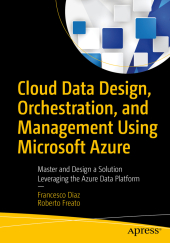 Neuerscheinungen 2018Stand: 2020-02-01 |
Schnellsuche
ISBN/Stichwort/Autor
|
Herderstraße 10
10625 Berlin
Tel.: 030 315 714 16
Fax 030 315 714 14
info@buchspektrum.de |

Francesco Diaz, Roberto Freato
(Beteiligte)
Cloud Data Design, Orchestration, and Management Using Microsoft Azure
Master and Design a Solution Leveraging the Azure Data Platform
1st ed. 2018. xviii, 438 S. 302 SW-Abb. 254 mm
Verlag/Jahr: SPRINGER, BERLIN; APRESS 2018
ISBN: 1-484-23614-9 (1484236149)
Neue ISBN: 978-1-484-23614-7 (9781484236147)
Preis und Lieferzeit: Bitte klicken
Use Microsoft Azure to optimally design your data solutions and save time and money. Scenarios are presented covering analysis, design, integration, monitoring, and derivatives.
This book is about data and provides you with a wide range of possibilities to implement a data solution on Azure, from hybrid cloud to PaaS services. Migration from existing solutions is presented in detail. Alternatives and their scope are discussed. Five of six chapters explore PaaS, while one focuses on SQL Server features for cloud and relates to hybrid cloud and IaaS functionalities.
What You´ll Learn
Know the Azure services useful to implement a data solution
Match the products/services used to your specific needs
Fit relational databases efficiently into data design
Understand how to work with any type of data using Azure hybrid and public cloud features
Use non-relational alternatives to solve even complex requirements
Orchestrate data movement using Azure services
Approach analysis and manipulation according to the data life cycle
Who This Book Is For
Software developers and professionals with a good data design background and basic development skills who want to learn how to implement a solution using Azure data services
1 Overview of data architecture on Microsoft Azure Introduction Technologies: everyone touched in the book plus some other edge technologies just mentioned. We explain the scenarios of the book. This chapter will be written during the whole process, updating it with the relevant content of the scenarios developed in the chapters.
2 Working with Relational DBs on Azure Relational DBs scenarios Technologies: VMs, Backup, Storage, SQL Server DR and GEO-DR, (Oracle, MySQL) We would like to cover the best practices to deploy standard RDBMSs while using Azure VMs and networking.
3 Working with Azure SQL Database Azure DB scenarios Technologies: Azure SQL DB, Stretch DB , Database Pools, Sharding data, Migration from other RDBMSs to Azure SQL DB This chapter is about the SQL Database PaaS, with some tricks for advanced usage. We cover the services and the connected services, how to scale with relational DBs and how to write multi-tenant applications.
4 Working with NoSQL alternatives NoSQL scenarios Technologies: Storage, DocumentDB, Redis, Azure Search This chapter enforces the polyglot persistence idea, where different technologies and data sources address different needs. The NoSQL alternatives can fill the gap of modern applications in terms of performance and feature set.
5 Orchestrate data with Azure Data Factory Integration scenarios Technologies: Azure Data Factory In this chapter we talk about integration of different data sources and advanced pipelines of data transformation. We explore some scenarios to lower the complexity of the Data Factory service and we see how to setup existing solutions to fit it.
6 Advanced analysis with Azure Data Lake Analysis scenarios Technologies: Data Lake Store/Analytics, U-SQL This is the first chapter about ingestion of big data. This is focused on ingestion of native data, to be prepared, enriched and evaluated/analyzed in a second step.
7 Real-time Ingestion, Processing and Prediction Real-time scenarios Technologies: Machine Learning, Stream Analytics, Event Hub This is instead focused in ingestion of well-known and structured data with the aim to process it in real-time. In addition a step of prediction is added to react (in real time too) to certain events.
8 Working with Big Data with Azure Batch and Map/Reduce Big data scenarios Technologies: HDInsight, Hadoop, Spark, R Server, Storm, Azure Batch This is the last chapter about Big Data, exploring the industry standard to perform data operations, while executing those engines on Azure.
9 APPENDIX (tbd yet, adding some of the topics below to one of the other chapter still has to be defined) Other Technologies: Azure Analysis Services (chapter 3?), Power BI (chapter 6?), Azure SQL DataWarehouse (chapter 6?), Azure Data Catalog (chapter 5?) Those technologies should fit the existing chapters, but we do not know where they best fit at the time being.


